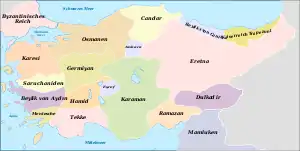Eretna
Eretna war der Name eines anatolischen Fürstentums (Beylik) mit Hauptstadt in Sivas und später Kayseri, das 1328–1381 bestand.

Die Herrscherfamilie war uigurischen[1] Ursprungs und übernahm nach dem Untergang der Ilchane die Herrschaft über einen Teil Anatoliens. Das Beylik erstreckte sich über Zentralanatolien und umfasste die heutigen Städte Niğde, Aksaray, Ankara, Develi, Karahisar, Darende, Amasya, Tokat, Merzifon, Samsun und Erzincan.
Benannt ist das Beylik nach dem Gründer Eretna, einem uigurischen Offizier[2] im Dienste der Tschupaniden.
Der Name Eretna leitet sich wahrscheinlich vom Sanskritwort Ratna = ‚Juwel‘ ab.
Während der Auseinandersetzungen zwischen den Tschupaniden und deren Oberherren, den Ilchanen, musste Eretna 1326 nach Ägypten fliehen. Er konnte später mit Hilfe der Mamluken sein Beylik errichten und ernannte sich zum Sultan. Er legte sich den Beinamen Ala ad-Din zu. Eretna starb 1352 und sein Sohn Ghiyath ad-Din Muhammed wurde sein Nachfolger. Er fiel aber schon 1365 einem Attentat zum Opfer und unter seinem Sohn war das Fürstentum schwach. Einige untergebene Fürsten rebellierten. Die Osmanen besetzten im Westen und die Aq Qoyunlu im Osten Gebiete der Eretna. Das Fürstentum wurde zwar nominell von Ala ad-Din Ali Beg regiert, doch in Wirklichkeit herrschte der Wesir Kadi Burhan ad-Din. Ala ad-Din Ali Beg starb 1380 auf einem Feldzug gegen die rebellischen Fürsten und Kadi Burhan ad-Din setzte sich gegen die Erben durch und wurde zum neuen Sultan. Damit endete das Fürstentum der Eretna.
Literatur
- Claude Cahen: Artikel „Eretna“. In: The Encyclopaedia of Islam. New Edition.
Einzelnachweise
- Art. „Eretna-Dynasty“ in: Online Encyclopedia Britannica, abgerufen am 28. Mai 2012.
- The New Encyclopaedia Britannica, Band 4, 2003, S. 538, Online Snippet: „The dynasty’s founder, Eretna, was an officer of Uighur origin in the service of Demirtas, the Il-Khanid governor of Anatolia“.
Bruce Alan Masters, Gábor Ágoston: Encyclopedia of the Ottoman Empire. Infobase, 2010, S. 41, Online Edition: „With the death of the Ilkhanid ruler Ebu Said in 1335, administration of Asia Minor was entrusted to his former governor Eretna Bey, originally an Uighur Turk, who eventually declared himself independent“.
Yılmaz Öztuna, Devletler ve hânedanlar: Türkiye : 1074 – 1990, Band 2. Türkiye Kültür Bakanlığı (Türkisches Kultur-Ministerium), 2005, S. 51.
John Freely: The companion guide to Turkey. HarperCollins, 1993, S. 391: „This was erected in 1339 by Eretna, an Uyghur Turk who created an independent principality in central Anatolia after the collapse of the Ilkhanid Mongol Empire in 1335.“
Jonathan M. Bloom: Sheila Blair. Oxford University Press, 2009, S. 60: „In the early 14th century, the city passed to the Uighur chief Eretna.“
The decline of medieval Hellenism in Asia Minor: and the process of Islamization from the eleventh through the fifteenth century. University of California Press, 1971, S. 139: „Governor Timurlash fled to Egypt in 1327, he was replaced by Ghiyath al-Din Ercrna (of Uighur origin) who succeeded in receiving official appointment from the Ilkhan Abu Sa'id.“
John Freely: The Companion Guide to Turkey. HarperCollins, 1993, S. 391: „This was erected in 1339 by Eretna, an Uyghur Turk who created an independent principality in central Anatolia after the collapse of the Ilkhanid Mongol Empire in 1335.“